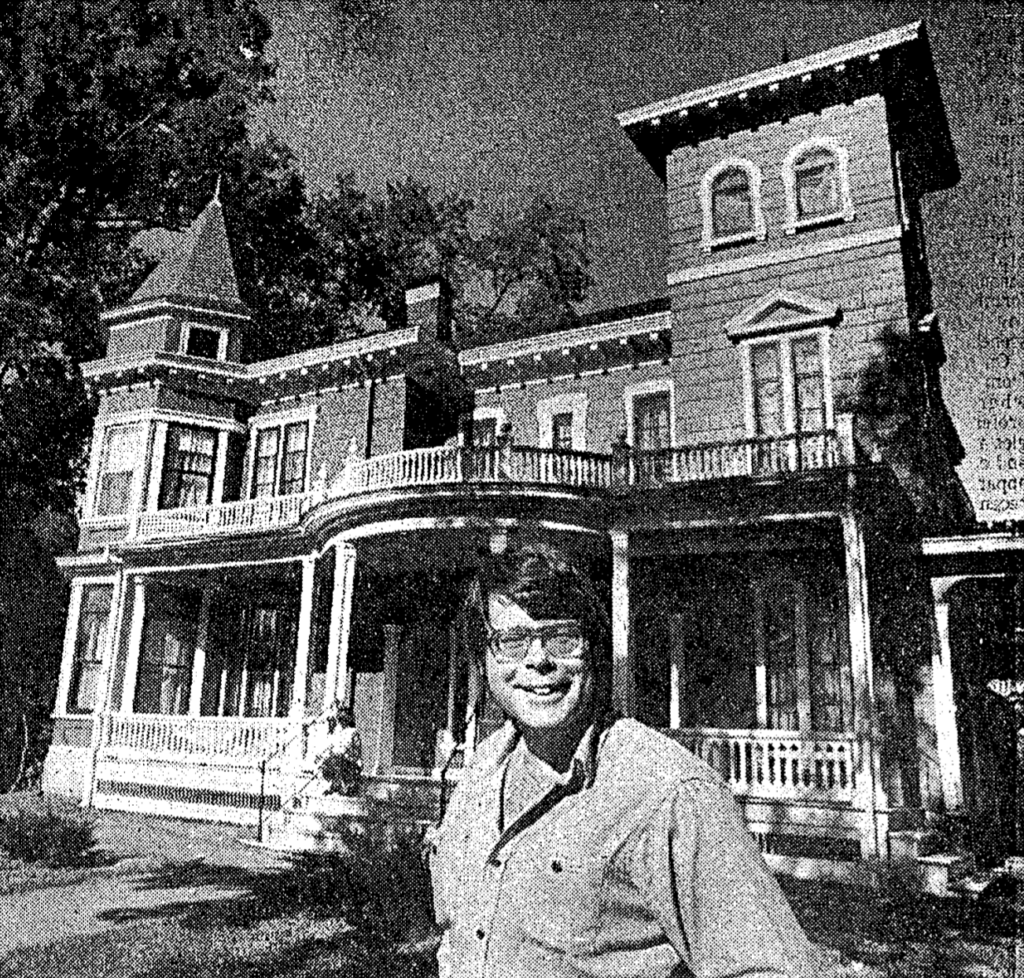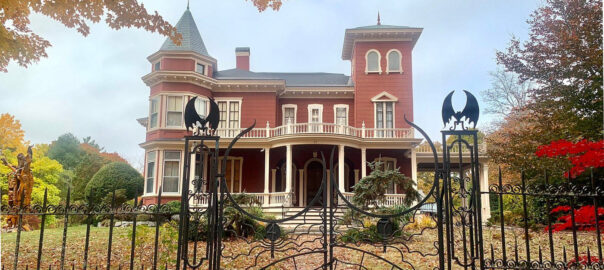The King family moved house several times between 1975 and 1980. In July 1975 they went from Boulder, Colorado to Bridgton, Maine, after having only lived in Boulder for a year. In the summer of 1977 the family traveled to England. They were supposed to stay for a year, as King wanted to write a novel about a ghost in a castle, but the novel never got going and after just three months they returned to the US in December. The Kings bought a property in Center Lovell, Maine. Half a year later (fall 1978), they moved north to a rented house in Orrington, near Bangor, when King was invited to teach at the University of Maine at Orono. In the spring of 1979 they returned to Center Lovell.
At this point, both King and his wife Tabitha were tired of all the moving around. They wanted to settle down permanently, and the rural house in Center Lovell was not the right place for that, for a number of reasons. Tabitha wanted their children to live near other kids. The Center Lovell house, with its picturesque setting beside Kezar Lake, was surrounded by summer homes, and the area was deserted for nine months of the year. The family also wanted the amenities and sense of community offered by a city. Tabitha suggested Portland, Maine, and King suggested Bangor.
In 1979 […] we looked in two places, we looked in the Bramhall district in Portland, and we looked on West Broadway in Bangor, which was the street that we both knew. Tabby from when she grew up in Old Town and would come in to use the library, and me from when I went to the university of Maine and used to come into Bangor to use the library. And we talked about it, and there were things about Portland that we liked very much, but what we liked about Bangor was a sense of community with no frills, a community where people really did seem to care about each other, where we had ties from our university years, where people had learned to get along with us, and to be friends with us in spite of the shrill politics of the late Sixties. (Source: YouTube)
The now-iconic house they bought was known locally then as the “William Arnold House”. It was the first house to be built on West Broadway Street, completed by William Arnold around the middle of the nineteenth century. “As a girl [Tabitha King] strolled down West Broadway with a friend and dreamed of living in one of the mansions. She leaned towards the red one with the towers [ie. the William Arnold House].”1 When the house came up for sale in 1980, the Kings did not hesitate. “I thought it was destiny,” Tabitha later remarked.1
At the beginning of July 1980, King spoke to a reporter of The Bangor Daily News and announced that the family would be moving there, and that Bangor would be the setting of a new novel he planned to write: “For five years I’ve wanted to write a book set in a fictional Maine city”. Of course he would change its name, adding menacingly: “For the purposes of my fiction, I would have to do whatever I have to do to Bangor”. King also mentioned the importance of the Bangor Public Library for his writing of the book: “Aside from the standard haunted house setting favored by horror writers, Bangor will provide the considerable resources of its public library, which King said contains one of the country’s best fiction collections and a lot of material about Bangor itself.” He intended to spend most of the winter of 1980-81 working on the first draft.2
United Press International noticed King’s announcement and sent out the following short item that was printed in the faits divers section of several newspapers under the heading “BANGOR BEWARE!”:
What Stephen King — master of powers dark and fell — did to Las Vegas in “The Stand”, he’s about to do to Bangor, Maine, in a book as yet untitled. King says he’ll make Bangor his permanent winter home, just so he can write his next thriller — and he’s characteristically sinister about it. Says he, “for the purposes of my fiction, I would have to do whatever I have to do to Bangor.” He will show the chamber of commerce one point of mercy. He’ll change the name. (The San Francisco Examiner, 7 July 1980, A13)
On the 27th of March 1983, when the family had not yet lived there a full three years, King was asked to speak about why he chose to live in Bangor, “from a novelist’s perspective”. That evening, King said:
West Broadway attracted us, with its graceful Victorian homes, its lovely trees, and its feeling of being a peaceful sort of inlet very close to the bustle of downtown. Fairmount School, a neighborhood school, a school our children could walk to, attracted us […]. […] Nevertheless, it was as much the novelist as the man who wanted to come to Bangor. I had a very long book in mind, a book which I hoped would deal with the way myths and dreams and stories — stories, most of all — become a part of the everyday life of a small American city. […] The real answer is that no, not any small American city would have done. Portland certainly wouldn’t have done. And no, I don’t know why. Maybe the book itself will answer the question (but if it does, I suspect the answer will lie in the narrow white spaces between the lines).3
As he was addressing the members of his new community King seems to have been hesitant to name the reason for choosing Bangor, saying, “no, I don’t know why”. On other occasions however, he had no problem stating that it was the city’s roughness that attracted him. A month after having moved there, King described Bangor to a reporter as a “hard town”: “They busted a lot of people here during the Viet Nam war. They won’t stand for much. It’s a hard-drinking, working man’s town. They’re just as likely to set fire to your hair in a bar if they don’t like the way you’re talking” (The Toronto Star, 5 October 1980).

King begun his work on IT not long after moving into the new house in August 1980. He was a guest on David Letterman’s morning show on the 18th of August, the first day of a seven-day promotional tour for his newly published novel Firestarter. At the end of the interview, Letterman asked if he was working on a new book, and King said:
It is very likely that King is referring to IT here. In previous interviews between 1978 and 1980, King had said that he had been carrying around a scary idea for five years about a thing “in a kind of a subway system” that was to be set in Bangor and that he intended to write after moving there. It seems that by the 18th of August, he had begun the draft.
Every morning, he added six new pages to his first draft of the novel. At the same time, King read the local history books he borrowed from the Bangor Public Library. He was equally curious about the town’s folklore as told by its inhabitants. “So I went around town for one whole fall, and I asked people what they knew about various places that I wanted to incorporate into the book. And I would listen to the stories” (TIME.com). One Bangor myth about the sewer system fit the story perfectly:
The real deal-maker was when I found out that there was this entire network of sewers under my city. A lot of people didn’t know where they went anymore. The maps had been lost. They were built in the thirties, as part of the Elenor Roosevelt Work Programs, and they just built these sewers, and then they left them. Some guy said to me, “Well you know, in the spring, when the run off comes from the snow, you can put a canoe in over at Westgate Mall and it will come out at Mount Hope cemetery”, you know, five or six miles on the other side of town. And I thought to myself, “Man, that’s probably not true, but it ought to be. And I ought to put my monster’s lair in those sewers, and at some point, I’ll have the kids go down there. (Source: YouTube)
A journalist from The Toronto Star, who visited King on the 18th and 19th of September 1980 when he had only been working on IT for a few weeks, reported on such an inspirational early morning walk:
King sets out on his walk to sniff at the book. Tabby goes with him and they pass “The Bangor standpipe”–a hundred-year-old water tower that may one day appear in one of his stories. They explore an 1870 bird bath in the middle of a common, pass a variety store that’s the setting for one of his short stories. When he gets back to the house he checks test papers that son Joe has brought home from school. At almost 9:30 he picks up his iced water and his vitamin pills and goes into his office off the dining room. (The Toronto Star, 5 October 1980)
Both the Standpipe and the bird bath, of course, made their way into the novel, as did many other Bangor myths. King’s street, West Broadway, also makes occasional appearances throughout the novel. It’s described as “West Broadway, where the rich whites in Derry lived then and still live today”, and the kids at Derry Elementary who live on West Broadway are all snooty and rude to the members of the Losers’ Club.
In the end, King spent the fall, winter, and spring working on IT, completing his first draft in June 1981. When the book was about to be published in 1986, King was a bit worried how people in Bangor would react: “I would not be at all surprised to find that I had become persona non grata in my own town following the publication of this book”,4 but, on the contrary, over the years Bangor has embraced its link with Stephen King and Derry.
- 1.Smith JH. A Girl’s Dream Comes True in Mansion Fit for Kings. Bangor Daily News. December 8, 1984:WM10-WM11.
- 2.Platt D. Novelist Stephen King to live winters in Bangor. The Bangor Daily News. July 3, 1980:23.
- 3.King S. A Novelist’s Perspective on Bangor. Black Magic & Music: A Benefit for the Bangor Historical Society. Published online March 1983:1-7.
- 4.King S. Stephen King Comments on It. Castle Rock: The Stephen King Newsletter. July 1986:1,5.
